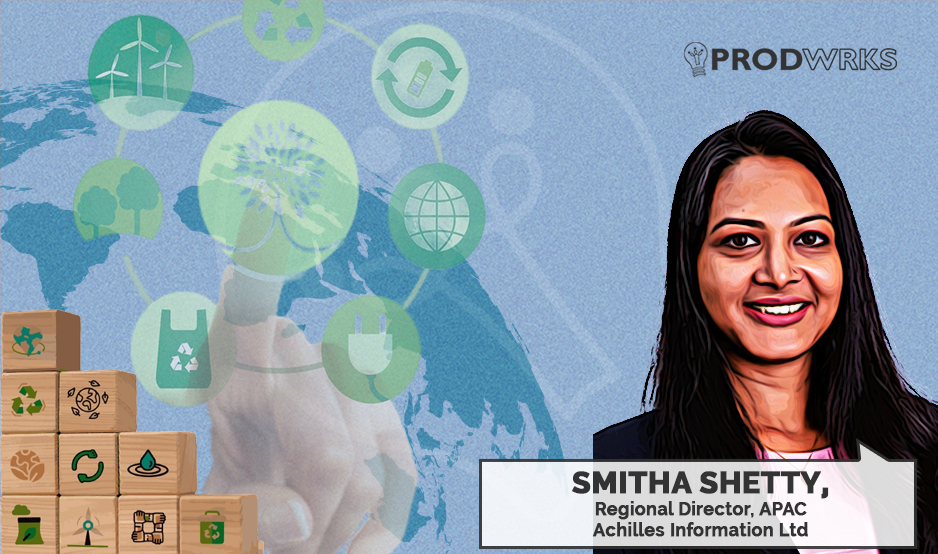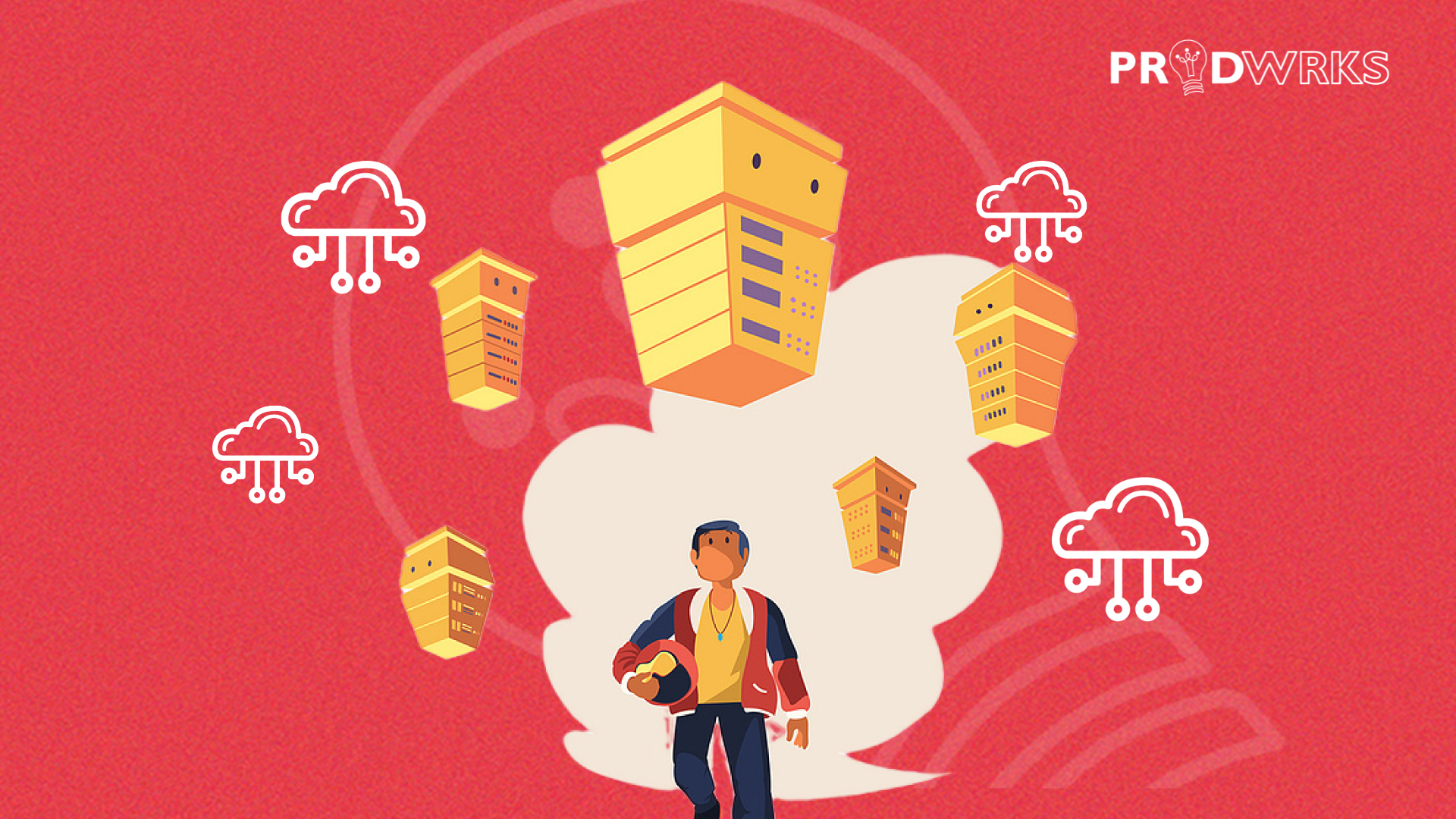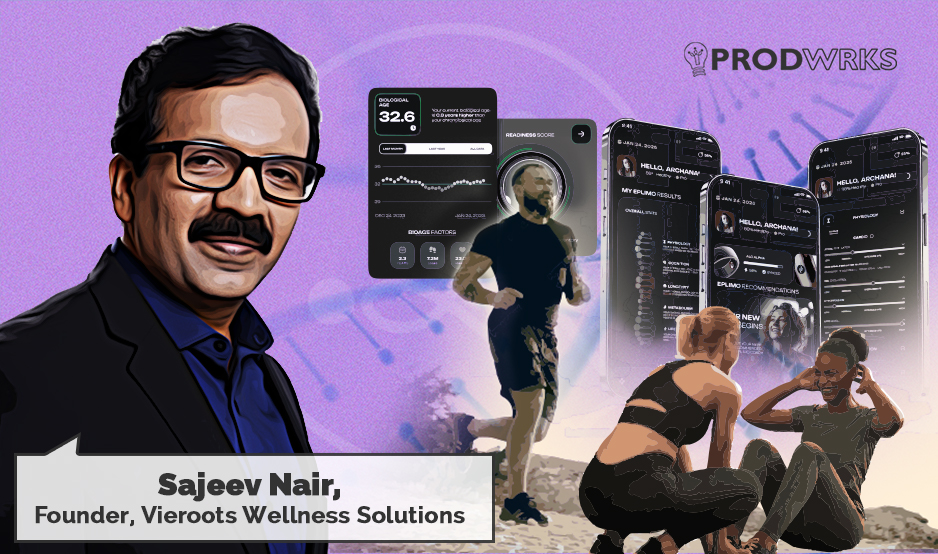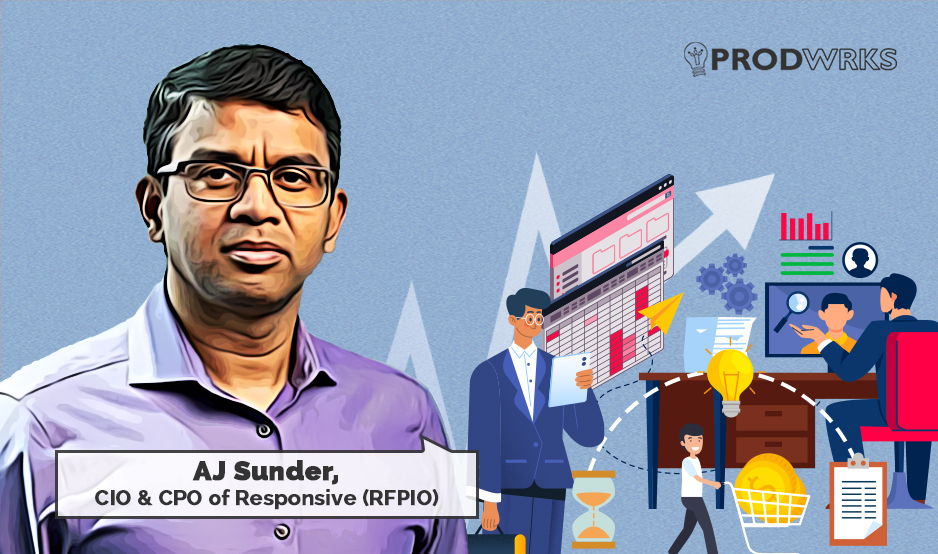
Responsive’s founders Ganesh Shankar (CEO), AJ Sunder (CPO/CIO), and Sankar Lagudu (COO), didn’t embark on their entrepreneurial journey with a specific problem in mind. All three shared a background in technology with a natural inclination towards the B2B software space, and they envisioned building a product that addressed a genuine, widespread need for business leaders. Their ambition wasn’t simply to chase the latest trends.
The spark arrived during a casual meeting. As the conversation veered towards Requests for Proposals (RFPs), a collective sigh of frustration filled the room. Each co-founder recounted countless hours and lost weekends creating repetitive, time-consuming RFP responses for potential clients, even though it wasn’t their primary job. It became clear – this wasn’t just a personal struggle; it was a widespread pain point for leaders in enterprises of all sizes.
AJ Sunder recounts, "We were all wasting so much time on creating RFPs. We were spending our Saturdays answering the same questions that we had already answered in a previous proposal, just because someone said a multi-million dollar deal would be held up if we didn’t complete it. It was blackmail. We knew there had to be a better way.”
Witnessing firsthand the inefficiency of the traditional RFP processes, Sunder and his co-founders identified their mission: to streamline and automate the crucial aspect of B2B response management and to build it better than existing solutions.
Thus RFPIO (rebranded in 2023 as Responsive.io) was born in 2015. Today, Responsive helps proposal teams craft higher-quality compliant RFPs, RFIs, and more in less time with AI.
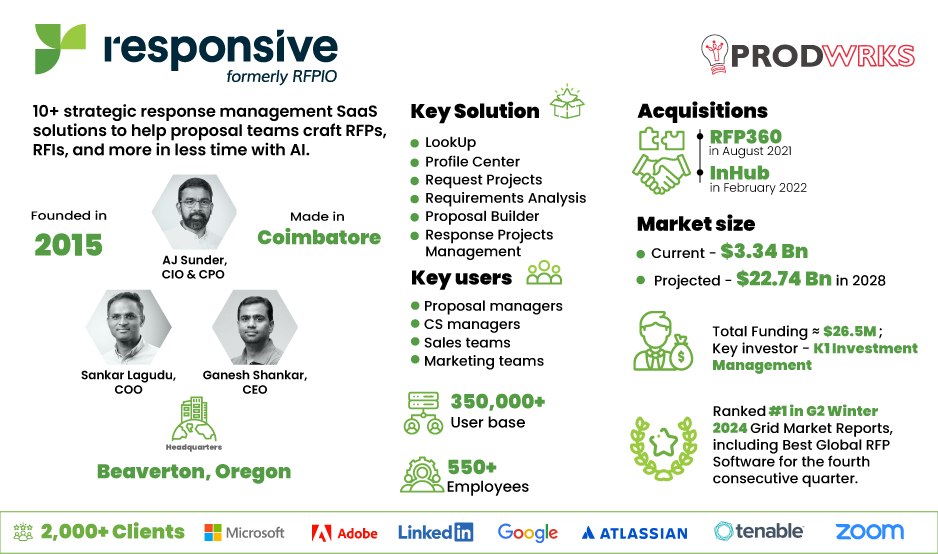

In a market which is estimated to grow to $22.7 billion by 2028, Responsive has nearly 2,000 customers i.e. 20% of the Fortune 100 including notable names like Google Cloud, Adobe, Atlassian, and LinkedIn. Most notably, the company has grown to serve over 300,000 users with its software built entirely out of Coimbatore!
How did they do it? Sunder shares some interesting gyan from Responsive’s journey.
Pick a Real Problem
“It has to be a real problem that comes naturally to you and it should be something that many people need a solution for. You have to be sure that you can solve it better than others. These are the three criteria. The RFP problem connected with us. We knew it was a real problem and we could solve it better. So it checked all the boxes and we never looked back.”
“I once gave a one-minute pitch to a room full of investors and asked them just one question - how many of you have ever completed RFPs in your life? Three-fourths of the people in the room raised their hands. I told them that I didn’t have to explain the problem to them and they got it. I wrapped up my one-minute pitch in 40 seconds and walked out of the room. We soon received calls from investors interested in the idea because that’s all that it took to explain.”
Do not use your beta customers as guinea pigs
“I don’t subscribe to the Silicon Valley mantra to fail fast. We did not want to use our beta customers as guinea pigs. The first version of our product included all the features we wanted our customers to have,” says Sunder.
“In the RFP space, proposal and data usually come as an MS Word or an Excel document. Our competitors at that time were asking users to manually upload proposal data in a standardized template. We never once considered that. We right away said people should be able to bring any document, in any format. That was our differentiator. Even our MVP had that feature.”
Get your first users to pay
The first milestone in validating your product is getting the first few customers to pay. It is probably the toughest part about starting up. Sundar emphasizes the value of avoiding free product giveaways during the validation stage.
“You must find users you can engage with while you're building the product. You must validate your product with them and bring them along the journey as you're building it. But make them pay for your product. Never offer it for free,” advises Sunder.
“People will not be willing to write a check if they don't see value. If they don’t pay, then you're not validating. In our case, we followed that playbook. As we started to build, we had a handful of paying customers and constantly stayed in touch with them to get feedback. We gave them favorable pricing early on as a beta customer to make them feel good.”
Get users outside your immediate circle
The second major milestone in product validation is getting external customers once you exhaust the inner circle of your personal and professional contacts and hit a plateau in new customer acquisition.
“The first few customers may have come from your contacts. When you get your first customer unsolicited or maybe from your marketing campaign, you don't know who they are and they don't know who you are. They just happen to find you because your product offers a solution to their problem. Signing these customers is the next major milestone.”
Get your users to renew their subscriptions
The third major milestone in product validation is product renewal. Getting the first customers may have been through contacts or marketing campaigns, but getting them to renew means that your solution is ready to hit escape velocity.
Sunder says, “Getting them to renew is probably the toughest validation milestone. When your first customers renew the product, it means they were not just doing you a favor by subscribing. It means that your product has reached a certain point where it has a proper fit, is solving a real problem and is solving it well. People talk about escape velocity and I think it comes down to the problem-solution fit.”
Validation doesn’t stop with user acquisition and retention
“You can convince someone to try your product. But for them to do it on their own, create a demo project, and then complete it without your guidance shows that there is value in your product. No one's going to spend time going through an RFP application and take hours to complete something if they don’t see value. That’s a major validation for your product.”
This makes it extremely important to build an easy-to-use product with feedback loops built in place to tell you what your users want, where they are getting stuck, and how you could improve your product to make it easier to use.
Establish Feedback loops - Users who complain are users who care
Building an extremely easy-to-use and easy-to-understand application is easier said than done. Especially in the early stages when startups are chasing features, it affects the re-usability of the product over time and Responsive was not immune to its negative effects.
Sunder’s team tackled it by making it easier for users to share feedback and it enabled them to incorporate continuous and quick improvements in the Responsive platform.
“Even our MVP included a way for our users to easily give us feedback. We put a lot of emphasis on it from day one and it became part of our values as well. We want anyone to be able to tell us what they think about our product. Users tell you what you could do better because they want you to do better. And that drives a lot of what Responsive does.”
He advises product leaders not to get disheartened by negative feedback. Users are not going to take the time to tell you what you are doing wrong if they don’t care.
“We cannot get it right every single time. And when you get it wrong, you hope your users care enough to tell you. The worst thing you can have is users who are not willing to talk to you. I will any day take a customer that complains and dislikes my product but talks to me about it, over someone who says, no, don't bother me,” says Sunder.
Collect feedback, but don’t become a feature factory
“In the early days, you have limited resources and your capacity dictates how much you can pursue. In some ways, it forces you to be disciplined. But after the product gets traction, the companies sometimes get into the trap of chasing after every single feature their early customers want,” Sundar explains.
“Product companies must ask the foundational questions - Does this feature make sense? Should we be investing time in this? Is this going to bring value to the majority of our users? Sometimes, we forget to ask these questions before building a feature in the pursuit of signing an attractive brand as a customer who wants that feature.”
He says, “Sometimes when you get one of the biggest brands in the world as a customer, it might be worth it to not ask those questions and build the feature for the positive boost it can provide your business. But you have to know when to draw the line.”
He adds that many startups don’t know when to stop. They chase every idea while gathering feedback and pivot so many times that the next thing you know, “they’re just chasing ghost.”
Sundar surmises that the key is to have a balanced approach of listening to customer feedback without losing sight of product vision. Recognizing this balance was the biggest differentiator for Responsive and helped the team stay on track with their product roadmap.
B2B users expect consumer-grade experiences
“Twenty years ago, an average person may have only interacted with software applications while they were at work. Now with our modern smartphones and unlimited access to the internet, we come across dozens of applications every day. The end user expectations have evolved as a result. What people tolerated 10 years ago, they don't tolerate anymore.”
“Back in those days, an application probably will take 10-15 years before it starts to look dated. Now, it happens in just three to five years. Websites go through this look and feel evolution every three years. You can't wait for 10 years, like you did in the past. So, keeping up with that user expectation is a significant shift you must undertake, even if it's not a need.”
Revisit foundational problems - AI has shortened the R&D cycle
“Earlier, this kind of tech only existed in experimental libraries that you wouldn't dare put in a production-scale application. However, in the last four years, AI has evolved so fast that you can now go back and tackle problems that you were hesitant to solve in the past due to long-running R&D cycles. With current technical advancements, it has become so much easier now.”
“We can even help users make RFP decisions by enabling AI to tackle some fundamental questions - how does it align with your business? Is this something you should pursue? How can you improve your winning chances? Answering these questions takes a level of insight gathering that comes from your historical data. With AI, we can derive smart recommendations for our users on what proposals to pursue and call out risks. These are things that we are starting to solve.”
A word of caution. Don’t chase shiny new tech
“I don't believe in chasing after what's making the most headlines. Sometimes, product leaders get too enamored with the tech and the solution and where to apply it, instead of looking at the problems. And that's where a lot of mistakes get made.”
“We take a balanced approach. We were using the early versions of GPT before ChatGPT became a thing. We're not afraid to experiment. We ensure that we're constantly innovating and dedicate enough resources to R&D. At the same time, we are also careful about not chasing it too quickly or too much. If you go too far and commit to a certain tech that could go obsolete in two/three months, then you have a huge investment you have to throw out.”
“Sometimes we'll get it right, sometimes we'll get it wrong. One thing we don't do is panic just because the competition did something. We don't have to be first in everything. Don't chase after competition.”
Lessons Learned
Sunder’s story offers valuable insights for entrepreneurs and product leaders.
- Focus on real problems you understand. Leverage your experience to identify unmet needs and solve them better than others.
- Build a product with a clear differentiator. Don’t be afraid to challenge the status quo and offer a unique solution.
- Focus on user validation: Get your customers to pay, acquire customers outside your network, and build compelling products that make your users renew their subscriptions.
- Make it easy for users to provide feedback. Negative feedback is good and it shows users care and want your product to succeed.
- Don’t become a “feature factory” – Build features that align with your product vision and bring value to the majority of users.
- Keep up with the faster innovation cycle in B2B software to avoid your product becoming outdated.
- Leverage AI for faster innovation and solve problems previously considered difficult.
- Invest strategically in R&D – Stay ahead of the curve but avoid getting distracted by “shiny new tech.”
By following these principles, RFPIO, now Responsive.io, has carved a niche for itself in the B2B software market. Their story is a testament to the power of focusing on customer needs, building a user-centric product, and continuously adapting to market demands.

